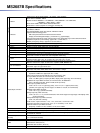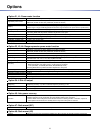
14
MS2687B Specifications
Specified values are obtained after warming up the equipment for 30 minutes at a constant ambient temperature and then
performing calibration. The typical values are given for reference, and are not guaranteed.
Frequency range 9 kHz to 30 GHz
Band Frequency range Mixer harmonics order [N]
0 9 kHz to 3.2 GHz 1
1– 3.15 to 6.3 GHz 1
Frequency band
1+ 6.2 to 7.9 GHz 1
2+ 7.8 to 15.3 GHz 2
4+ 15.2 to 30 GHz 4
Pre-selector range Pre-selector range: 3.15 to 30 GHz (band 1–, 1+, 2+, 4+)
± (Display frequency x reference frequency accuracy + span x span accuracy + resolution bandwidth x
Display frequency 0.15 + 10 Hz x N Hz)
accuracy Normal marker: same as frequency display accuracy, Delta marker: same as span accuracy, N : Mixer
harmonics order
Frequency counter resolution
1 Hz, 10 Hz, 100 Hz, 1 kHz (counts the received frequency at the peak point inside the zone)
Frequency counter ± (Display frequency x reference frequency accuracy +2 x N Hz + 1 LSD)
accuracy (at S/N 20 dB or more and RBW 3 MHz or less), N : Mixer harmonics order
Frequency span
Setting range: 0 Hz, and 5 kHz to 30 GHz, accuracy: ±1.0% (band 0, 1), ±2.5% (band 2, 4)
∗ At single band sweep, data point 1001
Setting range: 300 Hz to 3 MHz (1, 3 sequence), 5 MHz, 10 MHz, 20 MHz (0 band)
Resolution bandwidth ∗ Manually settable, or automatically settable according to frequency span
(RBW) [3 dB bandwidth] Accuracy: ±20% (300 Hz to 10 MHz), ±40% (20 MHz)
Selectivity (60 dB: 3 dB): ≤15 : 1
Video bandwidth (VBW) 1 Hz to 3 MHz (1, 3 sequence), Off ∗ Manually settable, or automatically settable according to RBW
Signal purity
Noise singleband: ≤–108 dBc/Hz (1 GHz, 10 kHz offset), ≤–120 dBc/Hz (1 GHz, 100 kHz offset)
Spurious resulting from local cause: ≤–65 dBc (at harmonic mixing order 1)
Frequency: 10 MHz
Reference oscillator
Start-up characteristics:
≤5 x 10
–8
(after 10 minutes warm-up, with frequency after 24 hours warm-up referenced)
Aging rate: ≤2 x 10
–8
/day, ≤1 x 10
–7
/year (with frequency after 24 hours of warm-up referenced)
Temperature characteristics: ±5 x 10
–8
(0 to 50˚C, with frequency at 25˚C referenced)
Measurement range: Average noise level to +30 dBm
Maximum input level
Continuous average power: +30 dBm (RF ATT: ≥10 dB)
Peak pulse input: +47 dBm (pulse width ≤1 µs, duty ratio ≤1%, RF ATT: ≥30 dB)
DC voltage: 0 Vdc
Average noise level display
RBW: 300 Hz, VBW: 1 Hz, RF ATT 0 dB, in SAMPLE detection mode
≤–124 dBm + f [GHz] dB (1 MHz to 2.5 GHz, band 0)
Level measurement
≤–120 dBm + f [GHz] dB (2.5 to 3.2 GHz, band 0)
≤–115 dBm (3.15 to 7.9 GHz, band 1)
≤–113 dBm (7.8 to 15.3 GHz, band 2)
≤–103 dBm (15.2 to 30.0 GHz, band 4)
Residual response: RF ATT 0 dB, input terminated at 50 Ω
≤–100 dBm (1 MHz to 3.2 GHz, band 0),
≤–90 dBm (3.15 to 7.8 GHz, band 1)
Setting range
Log scale: –100 to +40 dBm or equivalent level, Linear scale: 2.24 µV to 22.4 V
Unit
Log scale: dBm, dBµV, dBmV, dBµV (emf), W, V, dBµV/m
Linear scale: V
Reference level accuracy:
±0.5 dB (–49.9 to 0 dBm), ±0.75 dB (+0.1 to +30 dBm, –69.9 to –50 dBm), ±1.5 dB (–80 to –70 dBm)
Reference level ∗ After calibration, at 50 MHz, span: 1 MHz (when RF ATT, RBW, VBW, and sweep time set to AUTO)
RBW switching uncertainty:
±0.3 dB (300 Hz to 5 MHz), ±0.5 dB (10, 20 MHz)
∗ After calibration, with RBW 3 kHz referenced
Input attenuator (RF ATT):
Setting range: 0 to 70 dB (10 dB step), manually settable, or automatically settable according to reference level
Switching uncertainty: ±0.3 dB (10 to 50 dB), ±0.5 dB (50 to 70 dB)
∗
With 50 MHz, RF ATT 10 dB referenced
FrequencyAmplitude


















